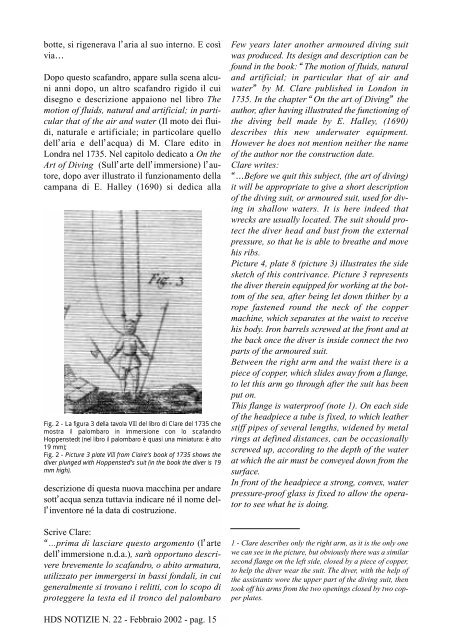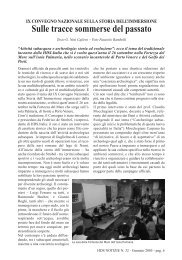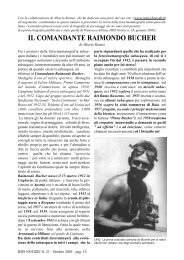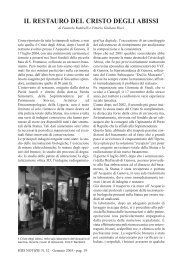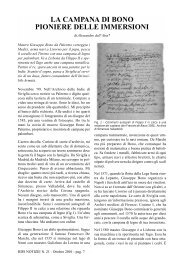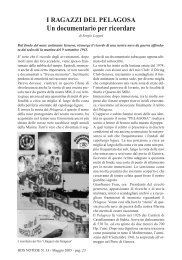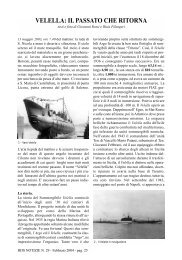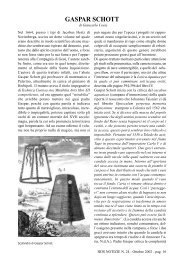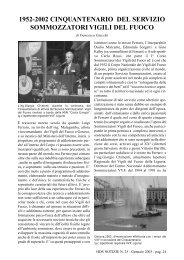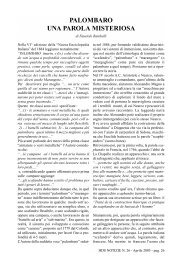hds internet - The Historical Diving Society Italia
hds internet - The Historical Diving Society Italia
hds internet - The Historical Diving Society Italia
You also want an ePaper? Increase the reach of your titles
YUMPU automatically turns print PDFs into web optimized ePapers that Google loves.
otte, si rigenerava l’aria al suo interno. E così<br />
via…<br />
Dopo questo scafandro, appare sulla scena alcuni<br />
anni dopo, un altro scafandro rigido il cui<br />
disegno e descrizione appaiono nel libro <strong>The</strong><br />
motion of fluids, natural and artificial; in particular<br />
that of the air and water (Il moto dei fluidi,<br />
naturale e artificiale; in particolare quello<br />
dell’aria e dell’acqua) di M. Clare edito in<br />
Londra nel 1735. Nel capitolo dedicato a On the<br />
Art of <strong>Diving</strong> (Sull’arte dell’immersione) l’autore,<br />
dopo aver illustrato il funzionamento della<br />
campana di E. Halley (1690) si dedica alla<br />
Fig. 2 - La figura 3 della tavola VIII del libro di Clare del 1735 che<br />
mostra il palombaro in immersione con lo scafandro<br />
Hoppenstedt (nel libro il palombaro è quasi una miniatura: è alto<br />
19 mm);<br />
Fig. 2 - Picture 3 plate VIII from Claire’s book of 1735 shows the<br />
diver plunged with Hoppensted’s suit (in the book the diver is 19<br />
mm high).<br />
descrizione di questa nuova macchina per andare<br />
sott’acqua senza tuttavia indicare né il nome dell’inventore<br />
né la data di costruzione.<br />
Scrive Clare:<br />
“...prima di lasciare questo argomento (l’arte<br />
dell’immersione n.d.a.), sarà opportuno descrivere<br />
brevemente lo scafandro, o abito armatura,<br />
utilizzato per immergersi in bassi fondali, in cui<br />
generalmente si trovano i relitti, con lo scopo di<br />
proteggere la testa ed il tronco del palombaro<br />
Few years later another armoured diving suit<br />
was produced. Its design and description can be<br />
found in the book: “<strong>The</strong> motion of fluids, natural<br />
and artificial; in particular that of air and<br />
water” by M. Clare published in London in<br />
1735. In the chapter “On the art of <strong>Diving</strong>” the<br />
author, after having illustrated the functioning of<br />
the diving bell made by E. Halley, (1690)<br />
describes this new underwater equipment.<br />
However he does not mention neither the name<br />
of the author nor the construction date.<br />
Clare writes:<br />
“…Before we quit this subject, (the art of diving)<br />
it will be appropriate to give a short description<br />
of the diving suit, or armoured suit, used for diving<br />
in shallow waters. It is here indeed that<br />
wrecks are usually located. <strong>The</strong> suit should protect<br />
the diver head and bust from the external<br />
pressure, so that he is able to breathe and move<br />
his ribs.<br />
Picture 4, plate 8 (picture 3) illustrates the side<br />
sketch of this contrivance. Picture 3 represents<br />
the diver therein equipped for working at the bottom<br />
of the sea, after being let down thither by a<br />
rope fastened round the neck of the copper<br />
machine, which separates at the waist to receive<br />
his body. Iron barrels screwed at the front and at<br />
the back once the diver is inside connect the two<br />
parts of the armoured suit.<br />
Between the right arm and the waist there is a<br />
piece of copper, which slides away from a flange,<br />
to let this arm go through after the suit has been<br />
put on.<br />
This flange is waterproof (note 1). On each side<br />
of the headpiece a tube is fixed, to which leather<br />
stiff pipes of several lengths, widened by metal<br />
rings at defined distances, can be occasionally<br />
screwed up, according to the depth of the water<br />
at which the air must be conveyed down from the<br />
surface.<br />
In front of the headpiece a strong, convex, water<br />
pressure-proof glass is fixed to allow the operator<br />
to see what he is doing.<br />
1 - Clare describes only the right arm, as it is the only one<br />
we can see in the picture, but obviously there was a similar<br />
second flange on the left side, closed by a piece of copper,<br />
to help the diver wear the suit. <strong>The</strong> diver, with the help of<br />
the assistants wore the upper part of the diving suit, then<br />
took off his arms from the two openings closed by two copper<br />
plates.<br />
HDS NOTIZIE N. 22 - Febbraio 2002 - pag. 15


